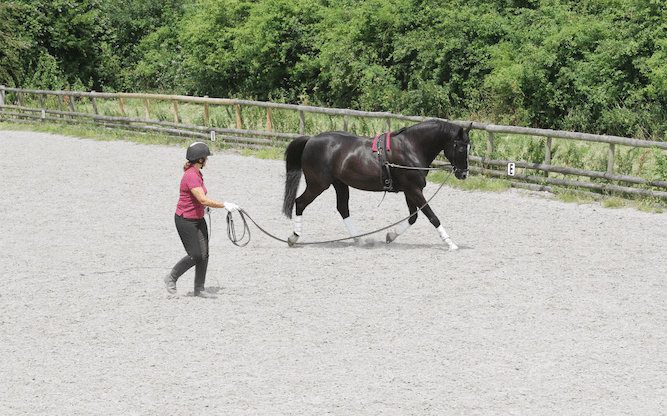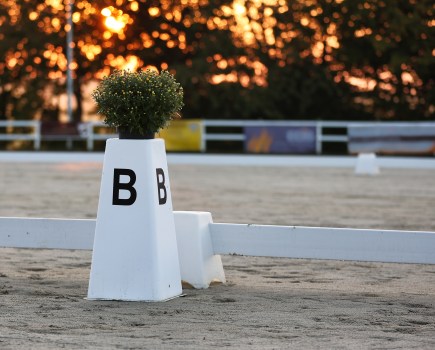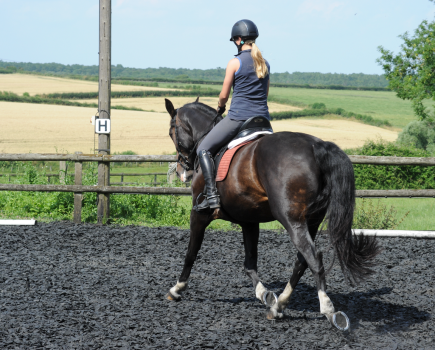Put simply, lunging involves a horse working in circles around you. It is possible for the horse to work in walk, trot and canter, and on different sizes of circle.
Although you will be the centre point of the circle, you won’t be standing still. Instead you will be making small steps as you turn your body so that you are facing the horse at all times.
Lunging position
Your position is key to successfully lunging a horse. You want to be no further forward than the horse’s shoulder, so that they are circling away from you.
While being the centre point of the circle, be careful not to step ‘in front’ of your horse so that they circles toward you.
By doing this you become a ‘blocker’ and the horse may turn in to look at you, slow down or even stop.
If you choose to use a lunge whip, you will hold this with the hand closest to the tail, pointing it towards the back end of the horse.
Your hand closest to the horse’s head holds the lunge rein.
This, along with your voice, is your main method of communication — think of it as being like the reins you hold when you’re riding — as it attaches to the cavesson (or bit if you choose to lunge in a bridle).
Any slack from the lunge rein should be held in your other hand.
Principles of lunging a horse
Lunging a horse is an excellent workout that is easy to incorporate into an exercise routine. When done correctly, it encourages a horse to use and develop all the right muscles that will improve their way of going when you ride.
“What people forget is that the scales of training apply even on the ground,” confirms classical dressage trainer and author Claire Lilley.
“Your horse is still in work, regardless of whether you’re sitting on their back or not, so rhythm, contact, suppleness and so on need to be achieved. There’s no quick fix for a hollow horse.
“When lunging a horse, they need to be encouraged to lower their head. This will engage and strengthen their abdominal muscles, and help them to work in an outline as they develop a stronger core,” continues Claire.
“Strong, supple horses should be able to stretch in walk, trot and canter with their noses practically on the ground, so using poles or anything that encourages them to look down may help to achieve this.”
Good technique
Grand Prix dressage trainer Sarah Ridd from Weymarsh Equestrian shares the following tips to help you have a great lunging session with your own horse:
1. Communication
“To give your horse clear aids and clear direction, your lunge rein and whip should form a triangle with your body,” says Sarah.
“Think of the lunge rein and whip as the two points at the bottom of the triangle, with you being the point at the top of the triangle.”
2. Move with your horse
“Don’t stand in the same spot, instead move with your horse. You’ll need to match the horse’s walk or trot steps to keep up with them.
“Your body language is important; if they are rushing, slow your steps down to signal that you would like your horse to slow down too, as well as using your voice to make long, peaceful sounds,” adds Sarah.
3. Increase the energy
“To encourage your horse to go forwards, rotate your whip from their hock towards their elbow. Short and snappy, upbeat voice sounds that are energetic are important too.
“Make sure there is a clear difference between your voice commands to go forward and to slow down. Your tone is what your horse is listening to, rather than the words.”
4. Stay in your own work space
“Your horse mustn’t encroach on your space. If they do, point your whip towards their head to encourage them to stay out and away from you,” advises Sarah.
“Sometimes, a soft wiggle of the lunge rein will help. You can also move your position to be further ‘behind’ the horse in the circle so that they are free to move forward.”
5. Cope with high jinks
If your horse has a moment and takes off on the lunge, don’t panic and immediately try to get them under control. If you get tense it will only activate their flight mechanism further.
“Instead, take a deep breath out, relax your shoulders and then calmly ask the horse to come back to a steadier pace,” says Sarah. “Sometimes a buck and a squeal is exactly what your horse needs to do before they are ready to knuckle down and work.”
Benefits of lunging
- Lunging is an opportunity for a horse to work without the weight of a rider on their back.
- From your position on the ground, you can watch how they move and spot any irregularities in their muscle development.
- It gives you a benchmark for what level their training is at and highlights the areas that need working on, such as improving their suppleness or balance.
- Lunging provides a thorough workout when you’re short on time and can’t ride — 20 minutes/half-an-hour max is plenty for most equines.
- You will also notice any stiffness on a rein and whether the horse favours striking off with a particular leg leading in canter. This information will help you formulate a targeted training plan for your horse.
Voice aids
One of my favourite things about lunging a horse is that it is a brilliant test of your communication, and how well you listen to each other.
Not all rider’s enjoying lunging a horse — and some horses don’t like being lunged either.
I have come to learn that it can have a useful place in a training programme. My horse lunges once a week or so.
I really enjoy working with him on the ground in this way; watching his ears flick as he listens to my commands. Being able to ask a horse to change from walk to canter and vice versa is quite some feeling.
Lunging a horse also gives you time to bond, watch how they move and learn how they use their body.
It is a useful way to take the edge off a fresh horse before you mount (I prefer one particularly skittish ex-racehorse I own to do his bucks without me on board), or to warm them up before a schooling session.
I lightly lunged my semi-retired first pony well into her thirties, because she needed to stretch her legs and I was too heavy to ride her. So you see, lunging is a useful skill to have.
Make it interesting
Lunging isn’t just about a horse trotting round in circles. That quickly becomes boring for both of you.
Here are a few things I do to stay focused:
- Plenty of transitions (and make them deliberate)
Ten steps of trot before walking, for example. Then 15 steps of walk before trotting again. I find this is a good test of how well you use your voice aids and how good your horse is at listening and responding to them. - Walk to canter and halt to trot transitions
My first horse, a Warmblood called Marcus, was very good at these. He was so tuned into my voice that he would change up and down perfectly. It took time to get to that point of course, but it was very satisfying when it worked. I have to be careful with these transitions with some of the Thoroughbreds I’ve owned over the years, though, as they find walk to canter exciting. - Vary the size of the circle
Ask your horse to spiral in to a 10m circle and then back out to 20m. Perhaps make an upwards transition as your horse gets back to the outside circle, or do a full circle at 15m before you spiral in or out. There are lunging reins with markers on to help you judge the circle size. Spiralling like this is a good stepping stone towards lateral work and will help to engage your horse’s hind leg.
As with anything, only try the above when you and your horse are ready and be patient, giving your horse time to learn what they’re being asked. You might not get it right straight away, and that’s OK.
A good session looks like…
Your horse will only feel the benefits of a lunging session when they are working correctly. Here are a few things to check for:
Tracking up
Check that their inside hind hoof comes up to or into the hoof print left by the inside fore leg.
Hips moving evenly
Watch your horse’s hips. On each rein you should be able to see each hip rise and fall evenly.
Stepping forward
You want to see the hooves stepping forward away from their hocks.
During the warm up, the horse’s hooves may stay in line with their hocks.
As their muscles warm up, they should step further under their body, creating better engagement and energy.
Engaging the core
Is there a weave line along the edge of their ribcage from the girth area up to their stifle? This tells you that your horse is engaging their core muscles, which in turn lifts their back.
Relaxed neck
The underside of the horse’s neck should look soft and the top of their neck should form an arc shape.
You may see a sausage-shaped muscle appear under their crest, too, if they’re moving correctly.
Floppy ears
The more relaxed your horse is in their jaw and poll, the floppier their ears will be. This is a good sign!
Best practice
It is vital to make sure you are using the correct equipment when lunging a horse. Don’t overdo it either, because a tired horse gets fed up and is more likely to injure themselves.
Warming up and warming down properly is also essential for helping your horse to work at their best and avoiding injury.
Bear in mind that it will take longer for them to warm up when it’s cold, and they may need a light rug on towards the end of your cool down so that they can continue walking without catching a chill.
Remove any training gadgets, like side-reins, during the cool down and let your horse warm-up before you attach them.
A horse who gets bored on the lunge may not behave so well next time you bring them out for a lungeing session either.
Make lunging interesting by varying the pace and making plenty of transitions too.
Depending on where your horse is at in their training, as well as direct transitions (walk to trot, for example) you can be more adventurous and ask for walk to canter, or halt to trot too.
Alternatively, while cantering, ask your horse for a few steps of trot before cantering again.
Transitions are a really good way to test how clear your voice aids are and how responsive your horse is to them.
Keep it natural
There are lots of exercises you can do while lunging a horse. Try using a turn-on-the-forehand to change the rein, for example. It’s a really good suppling exercise.
“Allow natural movement and rhythm on the lunge; nothing artificial is beneficial. Moving too fast causes tension; too slow will not develop movement,” explains Claire Lilley, who recommends doing the following when lunging a horse:
- Move around the arena and change direction regularly. Moving around allows for some straight line work for variety too.
- Ensure freedom of movement.
- Encourage your horse to stretch down using poles on the ground.
Using poles
Pole work is a great way to spice up a lunging session and make it more interesting for both you and your horse.
- Set four poles in a large star shape so that your horse can work around the outside of them on a 20m circle, or over them on a 15m circle.
- After three or four circles on each rein, take your horse around the school on straight lines by walking beside them.
- Doing this will improve the horse’s balance and prevent them from ‘motorbiking’ around the circle, which means falling in and taking too much weight on the inside hind and not enough on the outside hind
“Look for your horse to be taking weight evenly on all four legs. This is why it’s important to work them on straight lines as well as circles,” explains Claire.
Remember, every time you are lunging a horse, they need to spend an equal amount of time working on both reins.
And most importantly, make sure you both enjoy it!
Main image © Your Horse Library/Kelsey Media Ltd









